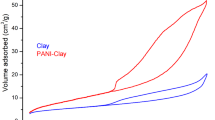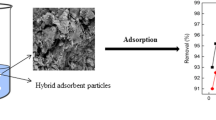Abstract
The aim of this work is to investigate the ability of an adsorbent of a clay mineral composite to remove and recover gold and silver ions from wastewater. The composite was prepared by mixing phosphogypsum (PG), obtained from an industrial waste, and a natural clay mineral. The materials were characterized before and after use in adsorption by several techniques. Batch adsorption experiments were carried out, and the effects of the contact time and the pH and temperature of solution on the removal processes were investigated. The optimum pH for the adsorption was found to be 4. The adsorption of these metal ions reached equilibrium after 2 h of contact. The pseudo-first- and the pseudo-second-order kinetic models, as well as the Freundlich and the Langmuir isotherm equations, were considered to describe the adsorption results. The maximum adsorbed amount of 85 mg·g−1 Ag(I) and 108.3 mg·g−1 Au(III) was found. The recovery of the adsorbed gold and silver ions from the adsorbent was also analyzed. Strong acids appeared to be the best desorption agents to recover gold and silver ions. The use of aqua regia gave regeneration rates close to 95.3% and 94.3% for Ag(I) and Au(III), respectively. Finally, the removal of gold and silver ions from an industrial wastewater was tested in batch experiments, and percentage recoveries of 76.5% and 79.9% for Ag(I) and Au(III), respectively, were obtained. To carry out the industrial application of the proposed methodology, an economic viability study is required.
Similar content being viewed by others
References
I. De La Calle, F. Pena-Pereira, N. Cabaleiro, I. Lavilla, and C. Bendicho, Ion pair-based dispersive liquid-liquid micro-extraction for gold determination at ppb level in solid samples after ultrasound-assisted extraction and in waters by electrothermal-atomic absorption spectrometry, Talanta, 84(2011), No. 1, p. 109.
M.A.Z. Abidin, A.A. Jalil, S. Triwahyono, S.H. Adam, and N.H.N. Kamarudin, Recovery of gold(III) from an aqueous solution onto a durio zibethinus husk, Biochem. Eng. J., 54(2011), No. 2, p. 124.
H. Ghassabzadeh, A. Mohadespour, M. Torab-Mostaedi, P. Zaheri, M.G. Maragheh, and H. Taheri, Adsorption of Ag, Cu and Hg from aqueous solutions using expanded perlite, J. Hazard. Mater., 177(2010), No. 1–3, p. 950.
C.P. Gomes, M.F. Almeida, and J.M. Loureiro, Gold recovery with ion exchange used resins, Sep. Purif. Technol., 24(2001), No. 1–2, p. 35.
R. Al-Merey, Z. Hariri, and J.A. Hilal, Selective separation of gold from iron ore samples using ion exchange resin, Microchem. J., 75(2003), No. 3, p. 169.
F.J. Alguacil, P. Adeva, and M. Alonso, Processing of residual gold(III) solutions via ion exchange, Gold Bull., 38(2005), No. 1, p. 9.
G.A. Kordosky, J.M. Sierakoski, M.J. Virnig, and P.L. Mattison, Gold solvent extraction from typical cyanide leach solutions, Hydrometallurgy, 30(1992), No. 1–3, p. 291.
Y.C. Chang and D.H. Chen, Recovery of gold(III) ions by a chitosancoated magnetic nano-adsorbent, Gold Bull., 39(2006), No. 3, p. 98.
H. El Bakouri, J. Usero, J. Morillo, R. Rojas, and A. Ouassini, Drin pesticides removal from aqueous solutions using acid-treated date stones, Bioresour. Technol., 100(2009), No. 10, p. 2676.
M. Ahram, H.N. Bhatti, M. Iqbal, S. Noreen, and S. Sadaf, Biocomposite efficiency for Cr(VI) adsorption: Kinetic, equilibrium and thermodynamics studies, J. Environ. Chem. Eng., 5(2017), No. 1, p. 400.
A. Kausar, G. MacKinnon, A. Alharthi, J. Hargreaves, H.N. Bhatti, and M. Iqbal, A green approach for the removal of Sr(II) from aqueous media: Kinetics, isotherms and thermodynamics studies, J. Mol. Liq., 257(2018), p. 164.
E. Antunes, M.V. Jacob, G. Brodie, and P.A. Schneider, Silver removal from aqueous solution by biochar produced from biosolids via microwave pyrolysis, J. Environ. Manage., 203(2017), p. 264.
M.L. Cantuaria, A.F. de Almeida Neto, E.S. Nascimento, and M.G. Vieira, Adsorption of silver from aqueous solution onto pre-treated bentonite clay: complete batch system evaluation, J. Cleaner Prod., 112(2016), p. 1112.
C. Jeon, Adsorption behavior of silver ions from industrial wastewater onto immobilized crab shell beads, J. Ind. Eng. Chem, 32(2015), p. 195.
C. Jeon, Adsorption and recovery of immobilized coffee ground beads for silver ions from industrial wastewater, J. Ind. Eng. Chem, 53(2017), p. 261.
A. Sarı and M. Tüzen, Adsorption of silver from aqueous solution onto raw vermiculite and manganese oxide-modified vermiculite, Microporous Mesoporous Mater., 170(2013), p. 155.
T. Wajima, Synthesis of zeolitic material from green tuff stone cake and its adsorption properties of silver(I) from aqueous solution, Microporous Mesoporous Mater., 233(2016), p. 154.
H.M. Al-Saidi, The fast recovery of gold(III) ions from aqueous solutions using raw date pits: Kinetic, thermodynamic and equilibrium studies, J. Saudi Chem. Soc., 20(2016), No. 6, p. 615.
M. Soleimani and T. Kaghazchi, Adsorption of gold ions from industrial wastewater using activated carbon derived from hard shell of apricot stones-An agricultural waste, Bioresour. Technol., 99(2008), No. 13, p. 5374.
R. Pérez-López, A.M. Álvarez-Valero, and J.M. Nieto, Changes in mobility of toxic elements during the production of phosphoric acid in the fertilizer industry of Huelva (SW Spain) and environmental impact of phosphogypsum wastes, J. Hazard. Mater., 148(2007), No. 3, p. 745.
N. Değirmenci, Utilization of phosphogypsum as raw and calcined material in manufacturing of building products, Constr. Build. Mater, 22(2008), No. 8, p. 1857.
H. Tayibi, M. Choura, F.A. Lopez, F.J. Alguacil, and A. López-Delgado, Environmental impact and management of phosphogypsum, J. Environ. Manage., 90(2009), No. 8, p. 2377.
S.K. Sahu, P.Y. Ajmal, R.C. Bhangare, M. Tiwari, and G.G. Pandit, Natural radioactivity assessment of a phosphate fertilizer plant area, J. Radiat. Res. Appl. Sci., 7(2014), No. 1, p. 123.
J.K. Yang, W.C. Liu, L.L. Zhang, and B. Xiao, Preparation of load-bearing building materials from autoclaved phosphogypsum, Constr. Build. Mater., 23(2009), No. 2, p. 687.
I.A. Altun and Y. Sert, Utilization of weathered phosphogypsum as set retarder in Portland cement, Cem. Concr. Res., 34(2004), No. 4, p. 677.
T. Kuryatnyk, C.A. da Luz, J. Ambroise, and J. Pera, Valorization of phosphogypsum as hydraulic binder, J. Hazard. Mater., 160(2008), No. 2–3, p. 681.
D. Parajuli, C.R. Adhikari, H. Kawakita, K. Kajiyama, K. Ohto, and K. Inoue, Reduction and accumulation of Au(III) by grape waste: A kinetic approach, React. Funct. Polym., 68(2008), No. 8, p. 1194.
T. Ogata and Y. Nakano, Mechanisms of gold recovery from aqueous solutions using a novel tannin gel adsorbent synthesized from natural condensed tannin, Water Res., 39(2005), No. 18, p. 4281.
S.K. Lagergren, About the theory of so-called adsorption of soluble substances, Kungliga Svenska Vetenskapsakademiens Handlingar, 24(1898), No. 4, p. 1.
Y.S. Ho, Review of second-order models for adsorption systems, J. Hazard. Mater., 136(2006), No. 3, p. 681.
A.E. Vasu, Adsorption of Ni(II), Cu(II) and Fe(III) from aqueous solutions using activated carbon, J. Chem., 5(2008), No. 1, p. 1.
I. Langmuir, The adsorption of gases on plane surfaces of glass, mica and platinum, J. Am. Chem. Soc., 40(1918), No. 9, p. 1361.
H. Freundlich, Üeber die Adsorption in Löesungen, Z. Phys. Chem., 57(1907), No. 1, p. 385.
Acknowledgement
Gil thanks Santander Bank for funding through the Research Intensification Program.
Author information
Authors and Affiliations
Corresponding author
Rights and permissions
About this article
Cite this article
Rakhila, Y., Elmchaouri, A., Mestari, A. et al. Adsorption recovery of Ag(I) and Au(III) from an electronics industry wastewater on a clay mineral composite. Int J Miner Metall Mater 26, 673–680 (2019). https://doi.org/10.1007/s12613-019-1777-x
Received:
Revised:
Accepted:
Published:
Issue Date:
DOI: https://doi.org/10.1007/s12613-019-1777-x




